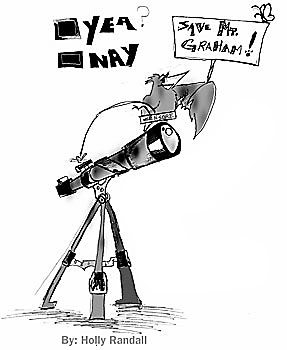
Illustration by Holly Randall
|
|
Arizona Daily Wildcat
Wednesday, October 20, 2004
Print this
Is the installation of the Large Binocular Telescope on Mt. Graham in the best interest of the UA and the community at large?
Next time, look for a better location
When planning began for the "Columbus Project," as the LBT was known before the barrage of problems, it was to be the biggest and most powerful telescope in the world.
Of course, it was supposed to be done in 1992.
Instead, a series of problems including the endangered red squirrel, the pure spruce, and concerns from the San Carlos Apaches have pushed full operation until at least 2007.
Now the LBT will be only the third-largest telescope.
In the meantime, both the telescope and the UA have missed out on the prestige the LBT would have brought.
And while it's nice to finally have the telescope, wouldn't it have been nicer to have avoided all the problems? To have it in a place where we wouldn't have to have a separate UAPD division to prevent protests?
Already the LBT is looking old. Next generation telescopes are in the planning stages, including the Extremely Large Telescope and the Overwhelmingly Large Telescope (I'm not making these names up).
Eventually we'll want to build another portal to the sky. We should look for a location that isn't going to cause so many conflicts and delays.
Granted, there are few places with extremely low humidity, high elevation, and low light. But if we look hard, they're there. Chile, for example, has the Atacama Desert, which meets the requirements. And they don't have squirrels.
So let's take our loss and look forward. Instead of shoving a telescope down the throats of multiple legitimate concerns, next time let's find a location that will allow us to get done on time.
Ryan Johnson is an economics and international studies junior. He can be reached at letters@wildcat.arizona.edu.
Telescope won't bring prestige to UA
Many people have lauded the University of Arizona's attempt to keep up with the world of astronomy, an attempt that culminated in Friday's official dedication of the Large Binocular Telescope on Mount Graham.
But despite the beliefs of the project's supporters, the telescope will not bring more prestige to the university; in fact, because of its less than state-of-the-art set-up as well as bad location, the positive aspects of the LBT might be overwhelmed by the negative effects.
Equipment-wise, the university's new telescope will be third in the world. For viewing power, it will rank behind both the Keck's Observatory in Hawaii and the European Southern Observatory in Chile.
You might be thinking that third in the world is great, but what further complicates the situation is the fact that Mount Graham has ranked 38th in the nation because of the number of nights with cloud cover.
In fact, many potential sponsors have pulled out of the project because of bad location. So even if the equipment were as grand as the university is making it, the location of the telescope leaves something to be desired.
If the University of Arizona wanted to boost its reputation, building the telescope on Mount Graham was a bad idea, especially considering the mediocre ranking and lack of support from the scientific and academic community.
In other words, even if you ignore the environmental complaints, there are still plenty of reasons why the telescope should never have been built on Mount Graham.
Laura Keslar is a pre-pharmacy junior. She can be reached at letters@wildcat.arizona.edu.
Telescope offends Native Americans
First off, let me say that I am a huge supporter of astronomy, and I usually support any increase in resources for our scientists to prefer.
However, the issues surrounding the Mt. Graham observatory make the situation much more questionable.
Looking at the issue from the Native American tribes' perspective - specifically, from the San Carlos Apache's perspective - the construction of the telescope on the mountain is a direct slight to their heritage, traditions, and religion.
To members of the Apache tribe, the grounds of Mt. Graham are sacred. It is a direct disrespect to their culture and to their religion to have anything built on it.
Granted a telescope isn't as bad as, say, if Wal-Mart wanted to build a Supercenter on the peak, but desecration doesn't really come in degrees.
The tribes claim that the telescope's construction bypassed the Native American Religious Freedom Act, and, according to the Mount Graham Coalition, the Apaches must acquire a permit 48 hours in advance to pray on the mountain. How would you like to have to get a permit to pray at your sacred place?
If the UA had planned a little better, then they could have avoided this whole issue. They could have chosen to locate in a location that wasn't considered sacred while still providing a good site for exploring the stars.
Hopefully, once completed, the telescope will be much more farsighted than the people who planned it.
Brett Berry is a regional development senior. He can be reached at letters@wildcat.arizona.edu.
LBT will make the UA a better place
The Large Binocular Telescope project on top of Mount Graham has brought about much controversy from Native American tribes and student environmentalist, which begs the question, "Why?" Yes, the telescope is being built upon the sacred land of Native Americans, and it might as very well be destroying the ecological diversity, but it's OK because Congress said it was OK.
In 1996, Congress excluded the Mount Graham telescopes from the American Indian Religious Freedom Act, Endangered Species Act, and the Environmental Policy Act. Congress gave the University of Arizona a golden pass to build on Mount Graham, which means it is a great idea.
Congress doesn't usually mess important decisions up, so the fact that Congress gave UA the thumbs up on this project means everything is peachy-keen.
To the students at University of Minnesota and the University of Virginia who are protesting the telescopes for cultural and environmental issues, you have to stop.
Continuing in protests will label you as citizens who don't support the United States government, which essentially means you're an anarchy-filled communist.
Not only does Congress agree with the project, but don't forget about all the prestige that will be brought to the UA with the LBT project. Once the telescope is built, it will be the third largest in the world. And since everything is better when it's bigger, that means Tucson is the third best body of land in the world when it comes to astronomy.
People from all over the world will venture to the Sistine Chapel of Arizona, also known as Tucson, and look at stars through our telescope. Wait, that's not it. If people are coming from all over the world to the UA, that means more diversity!
Not only will the UA be able to proclaim itself as the third-best piece of land in the world, but they can tout their extreme diversity as the best in the solar system. The LBT will make the UA a better place. I love the telescope project and you should too.
Moe Naqvi is a physiological sciences freshman. He can be reached at letters@wildcat.arizona.edu.
Mount Graham is a regional treasure
Mount Graham's Hudsonian ecosystem at its summit is a rarity among forests in the Southwest. The summit of the mountain, where the UA is constructing the LBT, belongs to a family of "sky islands" known as the Madrean Archipelago.
Mount Graham has more life zones than any other mountain in North America. The Hudsonian ecosystem serves as a habitat to 18 different plant and animal species that exist nowhere else in the world.
The most controversial and endangered is the red squirrel. Originally thought to have been extinct by 1965, scientists later discovered that a small number of them still live near the summit.
Logging and territorial issues with larger squirrels forced them into the northernmost region of the summit. Approximately 200 of these native Arizonan subspecies still exist.
Additionally, the area of land being used for the LBT is the flattest land at the summit. Part of their population has been forced to land with steep inclines. Daily tasks such as gathering acorns become difficult against the incline.
Astronomers claim these squirrels are more suited to the central regions of the mountain, but environmentalists refute this by saying that they have been forced out of the upper region and would return to the summit if the ecosystem were restored.
The importance of conserving this native "sky island" is undeniable. UA needs to realize the rich biological diversity of its mountains before they turn them into tourist spots.
When all 18 of the proposed telescopes are finished on the mountain, I'm sure that at least some if not all of the five ecosystems will be damaged.
The UA can find another place to pursue their own prestige and fame, because Mount Graham's unique biological diversity surmounts any man-made wonder in the state, lest the entire Southwest region.
Lauren Peckler is a sophomore majoring in English and sociology. She can be reached at letters@wildcat.arizona.edu.
 |
|
Susan Bonicillo
opinions editor
|
|
|
Mt. Graham gives UA unsavory distinctions
Every institution of higher learning tries to set itself apart from the pack.
The UA is no different.
In an attempt to distinguish ourselves, the UA has shown it support for the Large Binocular Telescope atop Mt. Graham.
This project is supposed to be our ticket to academic glory and fame.
Especially since the UA has such a long-standing reputation for having one of the finest astronomy departments in the country, if not the world, is motivation enough for us to uphold our standards. Being home to a telescope which will reportedly bring better images than even the Hubble will undoubtedly seal ourselves atop the intellectual totem pole.
Yet, on our way to garnering acclaim the UA has also garnered a variety of other distinctions that don't exactly speak highly of our institution.
Because of efforts to complete this project we've set precedents as a university with a rampant disrespect for laws.
We're the first university to fight against the rights of Native Americans and to fight against the listing of an endangered species.
We're the first to exempt ourselves from environmental protection laws.
We've tied up millions of dollars in litigation (and guess where that money comes from) in order to fund a project that even UA studies have claimed to be severely lacking in comparison to other sites.
Now, is this the kind of distinction that we want?
Susan Bonicillo is a junior majoring in English. She can be reached at letters@wildcat.arizona.edu.
